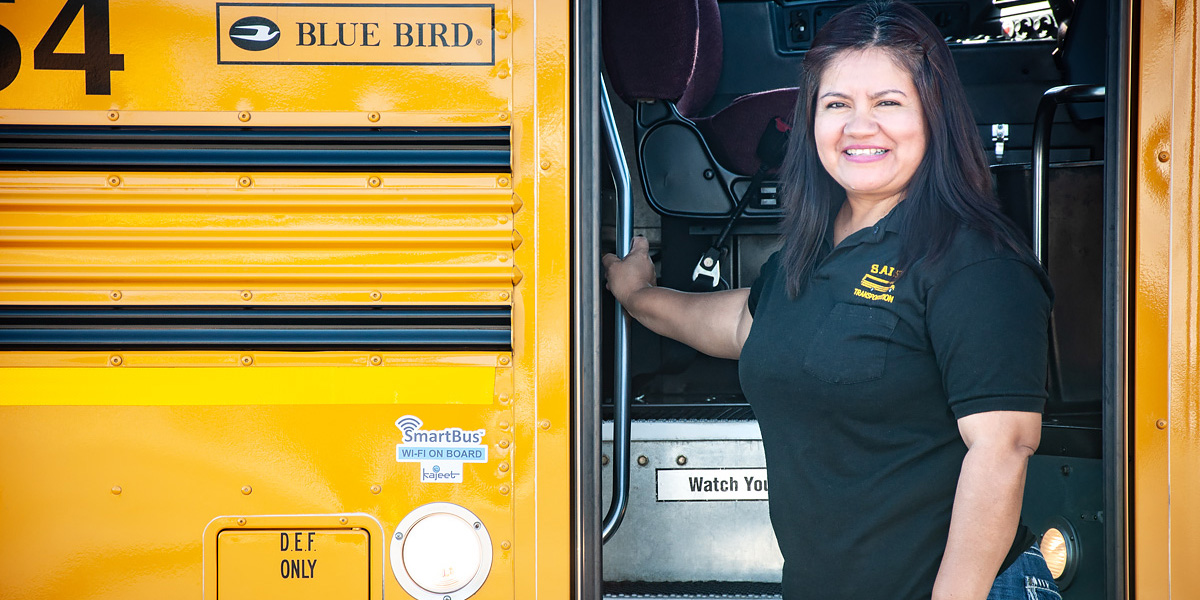According to a 2022 School Transportation News poll, 82% of K-12 transportation professionals have experienced an increase in behavior challenges from student riders during the pandemic. This increase in behavior incidents is only making it more challenging for transportation leaders to address the driver shortages and high turnover rates facing school districts across the country.
While there is not one easy answer when it comes to solving student behavior challenges on the bus – there are a few strategies which school districts have deployed that are helping to create a safer ride for both students and drivers by reducing the number of incidents on daily routes.
While bus drivers are celebrated as essential members of the school community, they are often forgotten when it comes to professional development and training opportunities.
A 2019 Campus Safety survey found that while 80% of drivers have received training to address bullying, nearly half of the drivers want more training to be made available to them, including:
Like teachers in a classroom setting, drivers need to be equipped with behavioral management strategies and insights into issues that arise during the school day to create a safe environment on the bus for students.
District leaders should work to provide drivers with the same training and PD that is offered to teachers and other school building staff for topics such as social emotional learning, crisis management, positive reinforcement, and more. Additionally, all school staff and transportation staff should be trained together in student behavior management so that students are getting a consistent experience both in the classroom and on the bus.
School bus WiFi has been gaining popularity in districts across the country as a way to extend the classroom – allowing students to complete online assignments and study for exams while traveling to and from school, athletic and extracurricular activities, and field trips. This technology makes a difference for students without reliable Internet access at home, and for those who have long daily routes to and from school.
What most districts did not realize when they equipped their fleets with WiFi, is that there would be an unintended benefit – reduced behavior incidents on the bus. It turns out that when students have safe, reliable access to the Internet on the bus, they stay focused on schoolwork and other appropriate online resources, keeping them in their seats and out of trouble.
The key to outfitting your buses with WiFi is the inclusion of CIPA-compliant filters. Web filters will keep students from accessing inappropriate content, like streaming applications and social media. Not only does this keep kids on task, but it also allows the driver to stay focused on the road and not on managing student device usage.
District Spotlight: In Raytown School District, they were receiving 500 disciplinary bus referrals annually. Once they equipped their fleets with WiFi in 2018, they were able to reduce the number of referrals by 45 percent. Additionally, they were able to save over 100 hours of administrative time (30 minutes per referral on average).
A certified teacher and researcher in school transportation, Sawyer Hogenkamp, M.Ed., has focused his studies on how to best improve school climate, particularly on school buses.
To set expectations with students and to foster better communication amongst administrators, staff, and drivers, Hogenkamp recommends that school administration and staff be present during bus pick up and drop-offs. Interacting with drivers and students during these times reinforces that the bus is an extension of the school building. It also demonstrates that the same rules apply in the classroom as they do on the bus and that the drivers are valued and have authority within the school community.
This time also gives administrators, staff, and drivers an opportunity to address any concerns they may have observed that could impact a student’s behavior in the classroom or on the bus that day.
As a district leader, if you are able to reduce behavior incidents on the bus, you can create a safer rider for both students and drivers. This will then lead to happier drivers – making a positive impact on driver recruitment and retention. This chain reaction ultimately creates a better environment for students to thrive academically. As Melissa Tebbenkamp, Director of the Instructional Technology at Raytown School District puts it, “If you think about the bus ride, it bookends your school day. If you can start and end your school day on a positive note, that will improve your overall perception of school. It can only have a positive impact.”
What strategies will you deploy in your district to decrease behavior incidents on the bus? If you are interested in learning more about Kajeet SmartBus™, the national leader in school bus WiFi solutions, you can check out the SmartBus WiFi page, download our Connected Bus Guide, contact us at smartbus@kajeet.com, or just use this handy blue button:

Amy Worst has been with Kajeet since 2016, and now serves as the Director of Marketing. She is a proud alum of Kutztown University and lives in Burke, Virginia with her husband and two dogs, Molly and Luna.

